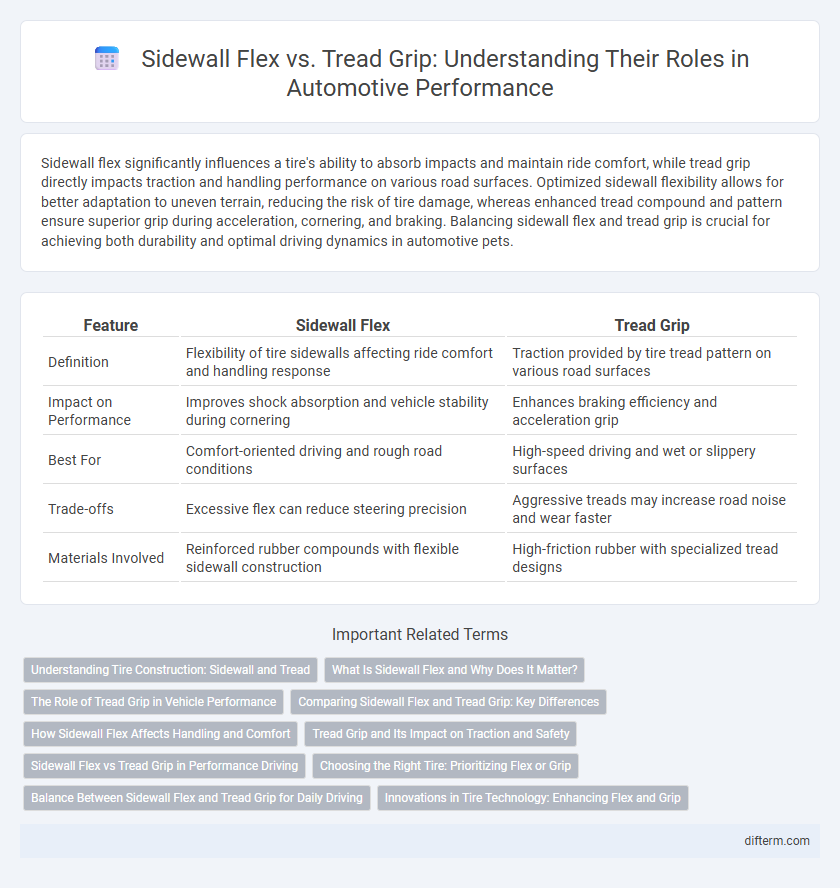Sidewall flex significantly influences a tire's ability to absorb impacts and maintain ride comfort, while tread grip directly impacts traction and handling performance on various road surfaces. Optimized sidewall flexibility allows for better adaptation to uneven terrain, reducing the risk of tire damage, whereas enhanced tread compound and pattern ensure superior grip during acceleration, cornering, and braking. Balancing sidewall flex and tread grip is crucial for achieving both durability and optimal driving dynamics in automotive pets.
Table of Comparison
| Feature | Sidewall Flex | Tread Grip |
|---|---|---|
| Definition | Flexibility of tire sidewalls affecting ride comfort and handling response | Traction provided by tire tread pattern on various road surfaces |
| Impact on Performance | Improves shock absorption and vehicle stability during cornering | Enhances braking efficiency and acceleration grip |
| Best For | Comfort-oriented driving and rough road conditions | High-speed driving and wet or slippery surfaces |
| Trade-offs | Excessive flex can reduce steering precision | Aggressive treads may increase road noise and wear faster |
| Materials Involved | Reinforced rubber compounds with flexible sidewall construction | High-friction rubber with specialized tread designs |
Understanding Tire Construction: Sidewall and Tread
Sidewall flex directly impacts ride comfort and handling responsiveness by absorbing road irregularities, while tread grip determines traction and braking performance on various surfaces. Tire sidewall construction involves materials like reinforced rubber and steel belts to balance flexibility and strength, enabling controlled deformation under load. The tread design and compound optimize surface contact and friction, essential for traction, making the interplay between sidewall flex and tread grip critical for overall tire performance.
What Is Sidewall Flex and Why Does It Matter?
Sidewall flex refers to the ability of a tire's sidewall to bend and absorb impacts while maintaining traction during cornering and uneven road conditions. A higher sidewall flex improves ride comfort by cushioning road irregularities but can reduce tread grip due to increased deformation under load. Balancing sidewall flex with tread stiffness is crucial for optimal handling performance, traction, and tire durability in automotive applications.
The Role of Tread Grip in Vehicle Performance
Tread grip directly impacts vehicle performance by enhancing traction on various road surfaces, improving acceleration, braking, and cornering stability. Unlike sidewall flex, which affects ride comfort and handling responsiveness, tread grip determines the tire's contact with the road, crucial for maintaining control at high speeds and during adverse weather conditions. Optimizing tread compound and pattern design significantly boosts grip, offering safer and more precise driving dynamics.
Comparing Sidewall Flex and Tread Grip: Key Differences
Sidewall flex affects a tire's ability to absorb shocks and maintain traction during sharp turns, providing a smoother ride and better handling on uneven surfaces. Tread grip primarily determines traction on various road conditions, including wet, dry, and icy surfaces, influencing braking and acceleration performance. Understanding the balance between sidewall flexibility and tread compound design is crucial for optimizing tire performance and vehicle safety.
How Sidewall Flex Affects Handling and Comfort
Sidewall flex significantly influences vehicle handling by affecting tire responsiveness and stability during cornering, with stiffer sidewalls providing more precise steering feedback and reduced body roll. This increased rigidity enhances tread grip by maintaining consistent contact with the road, improving traction and control. However, a stiffer sidewall can reduce ride comfort by transmitting more road vibrations to the cabin, while more flexible sidewalls absorb shocks better, offering a smoother driving experience.
Tread Grip and Its Impact on Traction and Safety
Tread grip significantly enhances traction by maximizing the contact area between the tire and road surface, especially in wet or slippery conditions. This improved grip reduces braking distances and increases cornering stability, directly contributing to overall vehicle safety. Superior tread compounds and patterns are engineered to optimize this grip, ensuring consistent performance across various driving environments.
Sidewall Flex vs Tread Grip in Performance Driving
Sidewall flex directly impacts vehicle handling by influencing the tire's contact patch and responsiveness during cornering, with stiffer sidewalls providing more precise steering feedback. Tread grip determines traction levels, especially in wet and dry conditions, affecting acceleration, braking, and overall stability. Balancing sidewall flex and tread grip is crucial for performance driving, as excessive flex can lead to delayed response while too rigid sidewalls may compromise ride comfort and tire durability.
Choosing the Right Tire: Prioritizing Flex or Grip
Choosing the right tire involves balancing sidewall flex and tread grip to optimize vehicle performance and safety. Tires with greater sidewall flex improve ride comfort and enhance handling responsiveness by absorbing road irregularities, while tires with superior tread grip provide better traction and braking efficiency, especially in wet or slippery conditions. Understanding the specific driving conditions and vehicle requirements helps in selecting a tire that prioritizes either flexible sidewalls for smoothness or aggressive tread compounds for maximum grip.
Balance Between Sidewall Flex and Tread Grip for Daily Driving
Achieving a balance between sidewall flex and tread grip is crucial for optimal tire performance in daily driving, as excessive sidewall flex can reduce steering precision while too rigid sidewalls may compromise ride comfort. Tires with moderate sidewall flex enhance shock absorption and maintain consistent contact with the road, improving overall handling and safety. Tread compounds and patterns designed for balanced grip ensure reliable traction on wet and dry surfaces, contributing to a smooth and controlled driving experience.
Innovations in Tire Technology: Enhancing Flex and Grip
Innovations in tire technology have led to advanced compounds and engineered sidewall structures that optimize sidewall flex without compromising tread grip, improving overall vehicle performance and safety. The integration of smart materials and adaptive tread designs enhances traction by dynamically adjusting grip based on road conditions and vehicle load. Enhanced sidewall flexibility also contributes to better shock absorption and maneuverability, elevating driving comfort and control across diverse terrains.
sidewall flex vs tread grip Infographic

 difterm.com
difterm.com